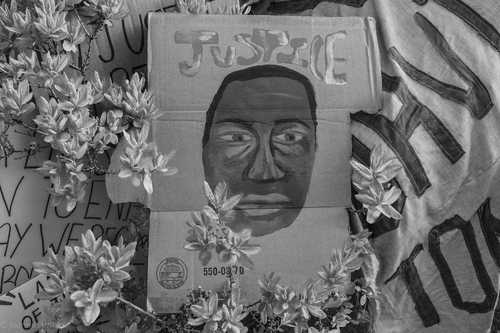Keywords: Protests
Item 11766
Tiananmen Square Protests, Portland, 1989
Contributed by: Maine Historical Society Date: 1989 Location: Portland; Beijing Media: Photographic print
Item 105921
Black Lives Matter sign, Brunswick, 2020
Courtesy of Tilly Laskey, an individual partner Date: 2020-06-04 Location: Brunswick Media: Digital image
Item 38168
277 Congress Street, Portland, 1924
Owner in 1924: St. Paul's Parish of Protestant Episcopal Church Use: Dwelling - Single family
Item 38169
Assessor's Record, 277 Congress Street, Portland, 1924
Owner in 1924: St. Paul's Parish of Protestant Episcopal Church Use: Dwelling - Single Family & Garage/Storage
Exhibit
Throughout the history of the state, residents have protested, on paper or in the streets, to increase rights for various groups, to effect social change, to prevent social change, or to let their feelings be known about important issues.
Exhibit
Post office clerks began collecting strong red, white, and blue string, rolling it onto a ball and passing it on to the next post office to express their support for the Union effort in the Civil War. Accompanying the ball was this paper scroll on which the clerks wrote messages and sometimes drew images.
Site Page
Presque Isle: The Star City - Potato import protest, Presque Isle, 1982
"Potato import protest, Presque Isle, 1982 Contributed by Maine Historical Society Description In a peaceful demonstration of opposition to…"
Site Page
Historic Hallowell - History Celebrated, Threatened and Preserved
"Citizens marched in protest from Hallowell to the state Capital and called for the creation of a National Historic District to preserve the downtown…"
Story
Black Lives Matter Protest Portland, Maine
by Joanne Arnold
Documenting the signage at Portland Police Station following the BLM Protests of June 2020
Story
Protesters spit on me as a Vietnam Veteran
by Joseph Rocque Jr.
I will never forget the horror of seeing all the protestors greeting my plane returning from Vietnam
Lesson Plan
World War I Sacrifice and Protest
Grade Level: 9-12
Content Area: Social Studies
Learn about World War I using primary sources from Maine Memory Network and the Library of Congress.
Lesson Plan
Grade Level: 9-12
Content Area: English Language Arts, Social Studies
Most if not all of us have or will need to work in the American marketplace for at least six decades of our lives. There's a saying that I remember a superintendent telling a group of graduating high-school seniors: remember, when you are on your deathbed, you will not be saying that you wish you had spent more time "at the office." But Americans do spend a lot more time working each year than nearly any other people on the planet. By the end of our careers, many of us will have spent more time with our co-workers than with our families.
Already in the 21st century, much has been written about the "Wal-Martization" of the American workplace, about how, despite rocketing profits, corporations such as Wal-Mart overwork and underpay their employees, how workers' wages have remained stagnant since the 1970s, while the costs of college education and health insurance have risen out of reach for many citizens. It's become a cliché to say that the gap between the "haves" and the "have nots" is widening to an alarming degree. In his book Wealth and Democracy, Kevin Phillips says we are dangerously close to becoming a plutocracy in which one dollar equals one vote.
Such clashes between employers and employees, and between our rhetoric of equality of opportunity and the reality of our working lives, are not new in America. With the onset of the industrial revolution in the first half of the nineteenth century, many workers were displaced from their traditional means of employment, as the country shifted from a farm-based, agrarian economy toward an urban, manufacturing-centered one. In cities such as New York, groups of "workingmen" (early manifestations of unions) protested, sometimes violently, unsatisfactory labor conditions. Labor unions remain a controversial political presence in America today.
Longfellow and Whitman both wrote with sympathy about the American worker, although their respective portraits are strikingly different, and worth juxtaposing. Longfellow's poem "The Village Blacksmith" is one of his most famous and beloved visions: in this poem, one blacksmith epitomizes characteristics and values which many of Longfellow's readers, then and now, revere as "American" traits. Whitman's canto (a section of a long poem) 15 from "Song of Myself," however, presents many different "identities" of the American worker, representing the entire social spectrum, from the crew of a fish smack to the president (I must add that Whitman's entire "Song of Myself" is actually 52 cantos in length).
I do not pretend to offer these single texts as all-encompassing of the respective poets' ideas about workers, but these poems offer a starting place for comparison and contrast. We know that Longfellow was the most popular American poet of the nineteenth century, just as we know that Whitman came to be one of the most controversial. Read more widely in the work of both poets and decide for yourselves which poet speaks to you more meaningfully and why.














